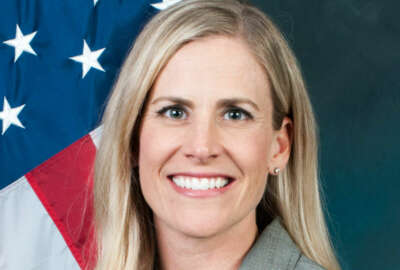
GAO tasked with accounting for money it takes to run entire government
It's not easy accounting for each of the $5.1 trillion it takes to operate the government every year. But someones got to do it.
Best listening experience is on Chrome, Firefox or Safari. Subscribe to Federal Drive’s daily audio interviews on Apple Podcasts or PodcastOne.
It’s not easy accounting for each of the $5.1 trillion it takes to operate the government every year. But someones got to do it. He may not count them all personally, but our guest tries to make some sense of out of this immense sum. Joining Federal Drive with Tom Temin with a summary of the summary, the chief accountant of the Government Accountability Office, Robert Dacey.
Interview transcript:
Tom Temin: Good to have you back.
Robert Dacey: Good morning, Tom.
Tom Temin: All right, so every year the GAO looks basically at the books of the nation as a whole, and you found that it’s a little bit easier to keep track of this year. Tell us how financial management, I guess you might call it, has improved somewhat over the past couple years.
Robert Dacey: Well, we’ve identified over the years several material weaknesses which have prevented us from giving an opinion on the government’s cruel based financial statements. And as a result of that Treasury and the agencies have undertaken a number of actions to address and reduce them. But at the end of fiscal year 19, we still have the same weaknesses we’ve had for several years, although improvements have been made.
Tom Temin: Are most of the weaknesses in the Defense Department’s ability to account?
Robert Dacey: There are three major obstacles for us giving an opinion. One was the serious financial management problems at the Department of Defense. But also we have a challenge with the inability to properly account for intergovernmental transactions between federal agencies. And there are some weaknesses in the process used by the government to prepare the consolidated financial statements for the government as a whole.
Tom Temin: I would think that the advent of the Data Act, which is now several years old, wasn’t that supposed to help this kind of thing so that everyone would have comparable information, and it would be easier to account for what happens agency to agency.
Robert Dacey: Certainly the Data Act has provided detailed transaction level information for
the agencies in both GAO and the inspectors general have issued reports on that information. But when you go to aggregate all these together, there are some challenges, like intergovernmental. What happens if an agency doing business with another doesn’t record the same transaction for the same amount in the same year? That presents a problem. So it’s aggregating the information that sometimes present the issue. As well as the auditing. Obviously, the agencies are required to be audited. And so there’s reasonable assurance about whether or not the financial statement information is reliable.Tom Temin: What is the source of these discrepancies agency to agency? Differing financial systems, different opinions about what should be counted or what?
Robert Dacey: Well, some of the intergovernmental transactions have been a problem since we first started auditing in 1997, that the magnitude of the differences has come down substantially since then. But at the end of fiscal year 19 we still had material amounts of differences for a variety of reasons. There’s timing differences. There’s differences between when the agencies record the transactions, the same transactions. There’s potential issues where they don’t record it or record in a different way, so they don’t offset properly. There’s a number of issues out there. Treasury has done a lot to work with the agencies to reduce that problem. For example, they have a quarterly scorecards issue which identify significant differences. They’ve also work with the agencies, too. Identify the root cause of some of the recurring differences so that can be addressed, and third, as a major area of that is the general fund which they’ve developed and produced and have looked hard to reduce the differences between the agencies and the general fund. So again, there’s a lot of good things happening, but we’re still in a place where there’s a material amount of differences between these intergovernmental transactions.
Tom Temin: A lot of the report seems to focus also on the projected reductions in Medicare cost growth, Social Security long term outlook. How does this all affect the financial outlook in the accounting quality of the country as a whole?
Robert Dacey: Well, in addition to the traditional financial statements that are cruel based, such as the assets we own, the liability which we owe and the taxes and revenues and costs that we incurred during the year, we have these sustainability financial statements, and they include long term projections of receipts and spending under current law and policy and those are helpful to understand whether or not we would expect. If we keep the current policies we have, we’ll have enough receipts to cover the cost in the future. So that’s an important area of analysis. When we looked at that area, we had one issue. There are significant uncertainties about the extent to which productive reductions in health care costs growth will be achieved or not, and so there’s a real problem there because of that uncertainty. Generally, management has indicated that’s likely that the cost will be higher than those that are presented in the projections. But the extent of those increases in costs is dependent upon to what extent legislation is enacted to ease some of those reductions, as well as the extent to which those additional costs will be offset by reductions in other cost areas or additional revenues. So to help illustrate the potential significance of these understatement of the amounts in those statements, the Department of Health and Human Service’s prepares an alternative projection as a result of that. And it basically assumes that some of these reductions and cost growth will not be fully achieved. That projection, the alternative projection, is about 23% higher than the amount in the statement. So there’s a wide range of potential variability and because of that, we’re unable to give an opinion on those sustainability statements.
Tom Temin: And in the case of those particular sustainability issues, we’re talking multiple tens of trillions of dollars, correct?
Robert Dacey: Yeah, the sustainability statements for the government as a whole project that the difference between receipts and spending, the present value receipts and spending over the 75
years, is about $49 trillion. What this means that if we don’t change our current policies, debt as a percent of GDP will continue to grow. At the end of fiscal year 19 it was about 79% and the projections would indicate that in 75 years that would go up to 474% of GDP. Just to give you some context, the average percent of debt to GDP since World War II is about 46% and the all time high was about 106% right at the end of World War II, which came down significantly after that. So that gives you some context of the magnitude. Another way we look at it is the concept called fiscal gap, and that’s how much would we need to change our revenues, increase our revenues or decrease their costs or some combination of the two, to keep debt as the same percentage at the end of the 75 years as the beginning, in this case against 79%. So to do that would require adjustments that would account for about 3.8% of GDP, present value of GDP. What that really means is that if youwere to close that gap to really get to that 79% of the under 75 years and you wanted to do it solely by raising revenues, you’d have to have about a 20% average increase across the 75 years to achieve that. If you had a one to close the fiscal gap by reducing costs, that would be about 17% reduction and cost. That gives you some idea of the magnitude and the extent that we don’t make these changes soon, that will end up costing us more in the long run. There are a couple of events in the not too distant future that will precipitate some action, I think on these areas. Number one, the Medicare Part A hospital insurance trust fund is projected to be depleted in 2026 at which time it won’t have enough revenues to pay full benefits. And secondly, the Old Agent Survivor’s Insurance Fund for Social Security is projected to become depleted in 2034. Again not having sufficient revenues to pay full benefits. So there’s approaching dates that you should keep your eye on.Tom Temin: And just to bring this all back down to earth on the regular day to day operations of the government. Are agencies in general at this point in history able to pretty much account for the way they expend the appropriations they get? Say, with the exception of the Defense Department.
Robert Dacey: Right. At the agency level, we’ve had significant improvement. When we first started doing audits in 1996, only six of the 24 CFO ACT agencies received clean opinions. In 2019 that numbers 22, which is fairly consistent with last year. But the Department of Housing and Urban Development did improve their position. They had a disclaimer last year, which means it couldn’t be audited. But this year they had a qualified report, which said except for certain areas, the financial statements were fairly presented. So they’ve worked hard, and that’s been a significant improvement. So the only one of the 24 CFO ACT agencies that hasn’t gotten opinion is the Department of Defense And so we also monitor about 16 other agencies that are significant to the government wide. There is some issues there because one of them Department of Defense, of course, didn’t get a clean opinion. But secondly, we did not audit the general fund this year to give Treasury time an opportunity to prepare and begin to implement a remediation plan for the issues we identified in our 2018 audit.
Tom Temin: I mean, the bottom line here is that there are some serious issues that Congress will need to deal with. And if you remove, say, the presidential candidates at the moment, all of them, no matter what party they’re from, because it’s boring to talk to crowds about this kind of thing. Do you find that the reception on Capitol Hill for this audit is pretty keen would you say when you release it every year?
Robert Dacey: There is a significant interest I believe in that as a side point to that, we expect issue in the next couple of weeks, our fourth annual report on fiscal health, which talks a lot more about sustainability and some of the implications of sustainability and what might be done to deal with it. Not in terms of policy proposals, but just some thoughts. And so that will be coming out shortly. And we’ll have testimony with that particular report as well. So there is interest in what’s going on there. And so we’ll see. We have recommended that Congress consider developing a long term plan to address the fiscal sustainability issues. Keeping in mind near term priorities and issues.
Tom Temin: Robert Dacey is the chief accountant of the Government Accountability Office. Thanks so much for joining me.
Robert Dacey: It’s been a pleasure to be with you today Tom.
Copyright © 2025 Federal News Network. All rights reserved. This website is not intended for users located within the European Economic Area.




